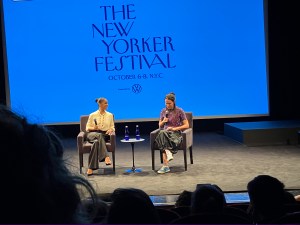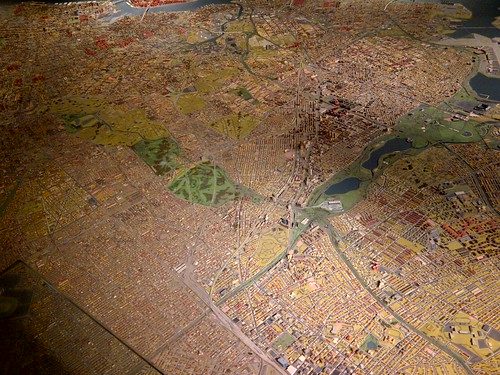
One of the great things about late September/October in NYC is that there are three events that are frequented just by New Yorkers. The first is Fall for Dance, which I have written about here, here, here, and here so far and will be continuing for night (day) five. Then there is The New Yorker Festival, which runs from a Friday to Sunday. Third is Open House New York. Some years all three happen in one weekend and I would run all over the city going from one event to another. This year, OHNY is happening this weekend, so it is not a conflict. I still have not decided which places I would like to visit. On top of all that, the NYC Comic Con usually happens on one of the weekends, so while you are traveling around Manhattan, you get a glimpse of the many costumes. (This year Comic Con was this past weekend, so it did not happen at the same time as the other events.) The weekend before last, The NYer Fest fell at the same time as the last weekend of Fall for Dance. I chose one NYer Fest event, which I think complemented the Fall for Dance weekend since it was an interview with dancing queen Misty Copeland interviewed by New Yorker writer Rivka Galchen.


The event was held at the SVA Theatre, which usually holds two events at the same time. This interview was in the smaller theater upstairs. There was a big crowd, most of whom were there for the Michael Pollan interview in the big theater. When I got inside and found my seat, there were very few people in the theater. Thankfully, the theater filled up before the interview. In the meantime, I texted my friends asking who Michael Pollan is and got a schooling in that. I had never heard of him, so did not know why he was so popular.
One of the nice things about waiting outside for a NYer Fest event is that you almost always get see the interviewee enter the event space. This was no exception, so I got a close glimpse of Copeland before she entered the theater and she is just as pretty and charismatic up close as you would expect.

I did not attend any NYer Fest events last year, so I do not know when this was implemented but now instead of microphones set up in the aisles for audience questions, you text your questions to a number up on the screen and the interviewer will read the questions after the formal interview. I like this change. We no longer have to hear people going on and on without asking a question or needing to tell a long story before the question. Of course, then the questions are curated by the interviewer, so you may not get to hear the question that might make the interviewee uncomfortable. Please note that I had a great view of the stage until a tall woman with a big head sat right in front of me and I had to keep leaning one way or the other to see.

Community was the word for the evening. It was mentioned when she spoke about her film, about her foundation, about her dancing, and about her life.
The interview began with them talking about Flower, the silent film short that Copeland stars in and produced. It is an homage to Black silent films of the 1920s with all the dialogue happening through dance. It is about a woman putting her dreams on hold while taking care of her mother who has dementia. The movie reflects what our society is going through, taking place in Oakland and it is about community and the housing affordability crisis. I was disappointed that we never got to see a piece of the film while we were there. For the movie, Copeland’s partner stalked Instagram for TURF (taking up room on the floor) dancers, which is an Oakland street dance. The male lead, Babatunji Johnson, is also a dancer.
For those who do not know, Copeland was the first African-American woman to be promoted to principal dancer in the American Ballet Theatre’s 75-year history. Copeland started dancing late in life for a ballerina (13yo), when a woman who wanted more diverse students in her ballet school found Copeland dancing at the Boys & Girls Club in Los Angeles. Before dancing ballet at the Boys & Girls Club, Copeland was dancing with her school’s drill team, which she auditioned for with no dance experience and she became captain. Her coach is the one who recommended her for ballet. At first, she was forced to dance when she had no interest but then she fell in love with ballet. Eventually Copeland lived with the teacher in order to be able to study more. Her mother had six children and wanted Copeland to give up dance at one point. Class was the one bright spot in her life since there was food and housing insecurity. Copeland turned out to be a prodigy and just before turning 15yo, she won first place in the Los Angeles Music Center Spotlight Awards. She was already receiving a lot of attention for her dancing before that.
Like all performers during the pandemic, Copeland was at a loss as to what to do without an audience. So she started a foundation to support all types of music and dance, especially in low-income communities. Skills like grace and focus are emphasized – skills that you can use over and over in all aspects of your life and can be used to create future leaders. One of the things that Copeland makes sure of is that the trauma she suffered from past teachers is not passed on. The teachers in her foundation would also have suffered trauma in their training and they are trained before they can teach the students.
In 2014, Derek Jeter asked her to become one of the athletes for Under Armour. Her Under Armour campaign was women-focused. Copeland has written a few books (with help). When talking about the books, especially her autobiography, she said that she gave her journals to her co-writer. Later, in an answer to an audience question, she said her writing process was different for each book but in describing the process, it seems that each were similarly written, with the co-writer pulling everything together from notes she provided. An extra purchase with our ticket was a copy of her book The Wind at My Back: Resilience, Grace, and Other Gifts from My Mentor, Raven Wilkinson. Wilkinson was the first African-American woman to dance for a major classical ballet company (Ballet Russe de Monte Carlo). She had to dance in Europe because in the 1950s her life was threatened when she danced in the South. Copeland found out that Wilkinson lived near her in the Upper West Side and Wilkinson became Copeland’s mentor. The book was written while Copeland was pregnant, so it was full of a lot of emotions, which her co-writer edited.

Galchen kept going back to pandemic questions. Copeland has not danced with ABT since 2019. She filmed the movie in 2021. And in 2022, she gave birth to her son. She does want to make her way back to the stage, but she does not know what that will look like yet. Dance is in her life with different projects. Even at home with family – her son is obsessed with Swan Lake and Le Corsaire.
Some of the audience questions:
Best advice: Have a good support system. Copeland often felt alone as the only Black dancer in ABT.
Live vs recorded music: With live music there is a connection with the conductor, who can change the tempo based on your dancing.
Starting at 13yo: Her body was ready for challenges. She would not have wanted to start dancing at 3yo.
Gains as an older dancer: Confidence from experience. Maturity. Taking on certain roles you could not do when you were younger but now that you have life experience.
Not as much growth or attention as should be on mental health in ballet.
Misty Copeland is as graceful in life as she is on the stage. I really enjoyed my hour with her.

By Carene Lydia Lopez

